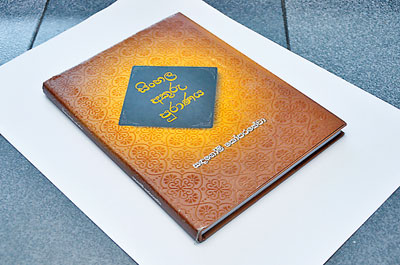Evolution of a classic language unfolds in a simple engaging style
View(s):George Bernard Shaw once enthused, “Ceylon is the cradle of the human race because everyone there looks an original”. The finely sculpted swarthy island people he admired share their classic character with the Sinhala alphabet. The beautifully curvy, full-figured Sinhalese letters are eloquent of an ancient civilization, chiselled on to rock and inscribed onto ola leaf over millennia.

Book facts: Sinhala Akuru Puranaya (A History of Sinhala Letters) by Sandagomi Coperahewa. Reviewed by Yomal Senerath-Yapa
The starkly ‘Hela’ or pure Sinhala name of the author of this book need not daunt the reader with the idea that he would employ an obscure or baroque Sinhalese. Well-known academic Sandagomi Coperahewa is the son of Sandadas Coperahewa- stalwart member of that staunch anti-Sanskritic Sinhalese literary organization the Hela Havula- but the book reads lucidly in simple, fresh language which flows beautifully like clear spring water. The author’s love for his subject and his strikingly easy mastery of the language makes the reading sheer pleasure- whether you are a scholar or not. The volume has been elegantly designed with a quaint orange and sepia theme, with illustrations. It can serve a wide readership: from the linguist and the student of typography to the casually curious.
In the study of a language, the letters are often a neglected aspect, and this work fills a void on scholarly shelves. The book begins by charting the evolution of the Sinhala script from the ancient Brahmi letters in the 3rd Century BC, absorbing, also, the shapes of South Indian writing systems while on the way to forming its own identity. For example it was the Grantha letters of the Pallavas that lent the Sinhala alphabet a more round form.
But the letters also changed due to the material on which they were written: the book explores the history of stone inscriptions, palm leaf manuscripts, the printed letter, the typewritten and the handwritten. Unique traditions associated with letters are explored, including the bequeathing of names, auspicious and inauspicious letters, and traditions of elaborate ‘bandana’ poetry where letters are arranged in certain patterns.
The chapter on reading, writing and primers hark back to the old rituals of a child’s initiation to literacy and the time-honoured customs associated with it. The book also comprehensively looks at the seven versions of the Sinhala hodiya (alphabet) and the elaborate classification of letters.
As with all languages, Sinhala has its idiosyncrasies and persisting controversies. It has an elaborate system of diacritics, which many have attempted to simplify (though these were all eventually thwarted), while two letters can serve for the same sound- which is rather baffling when it comes to orthography. But curiously, most bids at modernization have been stalled, while attempts to form a much simpler alphabet- such as Cumaratunga Munidasa’s ‘tharu akuru’ (the ‘star alphabet’) – were in vain.
The most fascinating factor of this comprehensive potted saga is that it shows how an ancient writing system has made its way into modernity, dodging- in the last century- Romanization as well as being given second status at home next to English. But the final chapter, discussing the graphical identity of Sinhala letters, features illustrations of the ‘lifestyle store’ cushions and ceramics sporting the Sinhala alphabet- giving off, inadvertently, the ominous message that the letters have become exotically ‘ethnic’ in their own country. The book ends with the new fonts designed for Sinhala, but one is left with a sense of uncertainty for the future of this classical language. It has survived into the 21st century, but, with social media and keener inroads made by English, will the writing soon be on the wall for our Sinhala akuru?


